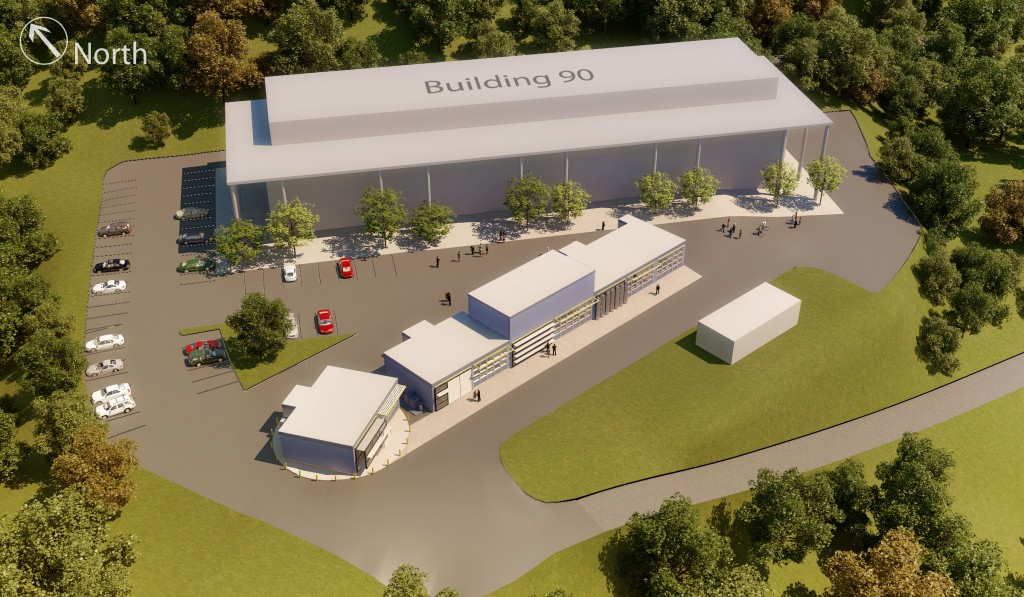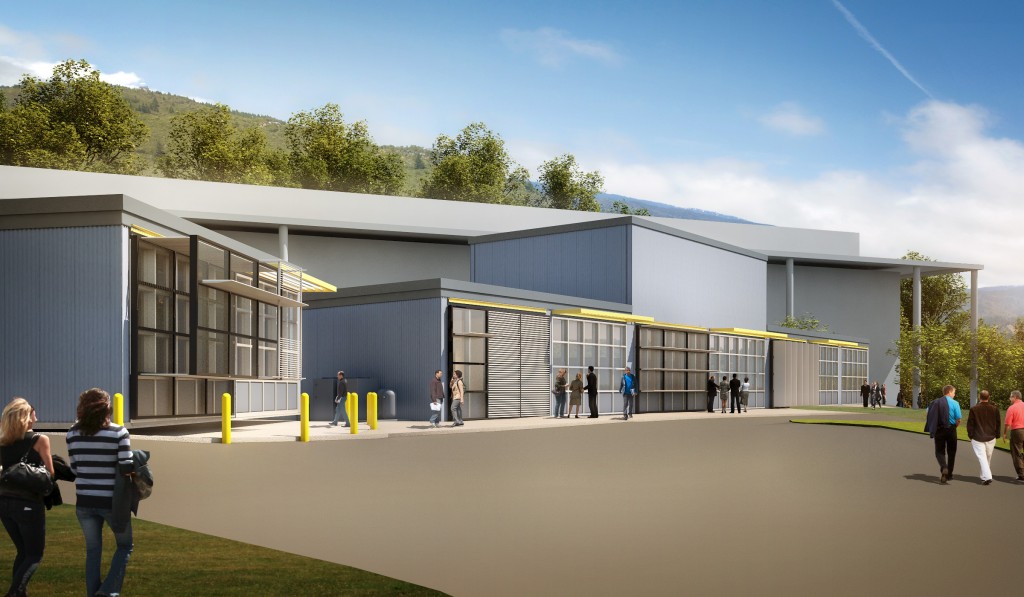Tools and Toys for Builders: New Test Center for Low-Energy Buildings

All types of snazzy technologies are available these days to make buildings greener: automated shades, electrochromic windows that know when to tint, intelligent lighting controls and smart cooling and heating systems, to name just a few. But how do these components work with each other and with building occupants? What happens when more than one technology is installed in a building? Do the current generation of building energy simulation programs provide accurate predictors of actual energy performance? Unfortunately, these questions are rarely answered since field-testing of integrated building technologies has not been a focus of the building industry.
Enter the new User Test Bed Facility at the Department of Energy’s Lawrence Berkeley National Laboratory. Like a giant, life-size set of building blocks, the Facility will allow researchers and manufacturers to test buildings systems and components under “real-world” conditions by swapping out systems and changing configurations and then allow rigorous monitoring of performance of every key building element that impacts energy consumption.
“One can think of these test beds as kind of an erector set. They’re designed with extreme flexibility in mind,” said Berkeley Lab engineer Oren Schetrit, a program manager for the Test Bed Facility. “You’ll be able to change out the walls, windows, lighting, HVAC [heating, ventilation and air conditioning] system, external or internal shading and the configuration of the internal office systems. You can also lower or raise the ceiling height and floor height.”
Today’s buildings (residential, commercial and industrial) consume more energy than any other sector of the U.S. economy, including transportation and industry, and are responsible for 40 percent of U.S. carbon emissions. As of 2006, commercial buildings accounted for 18% of primary energy consumption in the U.S. and used 36% of the nation’s electricity. Yet most buildings have at best a single meter that reports energy use on a monthly basis; only slightly better are the new generation of “smart meters” which provide a continuous stream of total energy use but no understanding of the end-use breakdown by component.
With advanced building technologies that are properly designed into integrated systems, commercial buildings can achieve dramatic energy savings—up to 80 percent or more for new construction and 60 percent or more for retrofits.

The User Test Bed Facility will be a one-of-a-kind center operated as a user facility by Berkeley Lab for the Department of Energy. Each test bed will consist of two side-by-side room-sized test cells, with one acting as the control and the other as the test condition. “We’ll be testing and optimizing integrated building systems, such as how does automated window shading impact heating and cooling loads. Those are technically challenging issues—hard to measure and hard to understand because they vary dramatically with weather conditions. This facility will allow us to accurately compare energy impacts side by side, including the effects of all major building systems,” says Steve Selkowitz, head of the Building Technologies Department and lead scientist on the project. “There’s really nothing like it in the world, operating at this scale.”
The Facility is being designed and built with $15.9 million from the American Recovery and Reinvestment Act. The design is currently being finalized; construction is scheduled to begin in the spring of 2012 and finish in the spring of 2013. It will be open to qualified academic researchers and industry alike and will focus on testing commercial building systems. “We’re looking for public and private partners to collaborate with us on groundbreaking new research,” Selkowitz says. “That collaboration can take many different forms. We want to be flexible to accommodate the business needs of industry and the mission of the Lab.”
Stantec Architecture is leading the architectural and mechanical/electrical/plumbing design for the facility, which incorporates input on the functional requirements of the test beds from researchers and industry. “This facility is challenging in requiring a wide array of flexibility in changeouts of different envelope and system components, while maintaining tight construction tolerances, high levels of sensing and instrumentation accuracy, and a robust and flexible controls and data acquisition system for the experiments,” says Cindy Regnier, program manager leading the technical development of the facility.
All of the test beds will be located at Berkeley Lab’s main site in the Berkeley hills, replacing a set of trailer buildings used as offices installed more than 30 years ago. Each test bed will be 40 feet by 30 feet, and can be split into two 20’-by-30’ cells. One of the four and a half outdoor test beds will be a high bay, or two stories, to allow testing of lighting and skylights applicable to markets such as big box retail stores. Another one of the test beds will be located in a renovated occupied space of an existing four-story office building, allowing for occupant feedback on tests of lighting controls, light levels and plug loads.
Additionally, one of the test beds will have the ability to rotate 270 degrees, which will allow for testing systems under west- and southwest-facing exposures, the most challenging for controlling peak cooling loads. “One of big issues of energy performance is the impact of sunlight,” explains Selkowitz. “If we can rotate it to face the sun for more hours of the day, we can get more interesting conditions to test under.”
The facility will also allow users to test the energy performance of retrofits. Of the 5 million commercial buildings in the U.S. many were built without the benefit of modern energy efficiency codes and can thus be improved using retrofits or renovation strategies. “You can, for example, set up one of the facilities with the equivalent of, say, 1970s or 80s buildings code construction, then test how much energy an aggressive retrofit strategy would save,” says Schetrit.
Selkowitz and his team are already meeting with a plethora of manufacturers of glazing, windows, facades, building HVAC and control systems and lighting fixtures and controls. The group includes large and small firms and startups as well as market leaders.
Besides manufacturers, another group of interested users are architects and engineers, those who specify what kinds of systems go into new buildings. “Architects and engineers need to have confidence in an emerging technology before they specify it because if it doesn’t work, they’re on the hook for it,” Schetrit says. “This is a place for them to kick the tires, experience what new technologies look like and work like. We want to facilitate the rapid transfer of emerging technologies to market.”
Another potential user of the facility are utility companies. California utilities alone spend over $1 billion a year to promote and incentivize established energy-savings technologies, such as CFLs, according to Selkowitz. “But for a lot of the newer technologies, like automated shading and daylight dimming, they don’t have ‘hard data’ on what the savings are,” he says. “Of course we can calculate that, but they really like to see measured data from the field. The test beds are designed to provide these data and will allow utilities to target their rebate and incentive programs to be more cost-effective.”
Berkeley Lab’s research will have even greater impact if it can be extended by collaborating with other building science user facilities nationwide. The Lab has been tasked by DOE to help create a national network of roughly 20 other building science test centers both public and private scattered around the country in order to share data across climates, technologies and building systems. Collecting, integrating and extending data from multiple sources, including the use of advanced simulation tools, will extend the value of everyone’s data, Selkowitz says.
Berkeley Lab operates six national user facilities, including the Molecular Foundry, the Advanced Light Source and the National Center for Electron Microscopy. The Lab’s Environmental Energy Technologies Division, which will be running the Test Bed Facility, also operates an Advanced Windows Test Facility, through which it has collaborated extensively with commercial companies and helped advance electrochromic glazing and other dynamic window control systems toward market applications.
“Berkeley Lab has been at the forefront of building science research since the program was started here over 35 years ago,” says Selkowitz. “These new test bed facilities will further enhance our capabilities, and we hope will launch a new era of scientific collaboration and accomplishment to help address the global problems of carbon emissions and climate change.”
Additional information:
- Berkeley Lab User Test Bed Facility
- DOE’s Buildings Technologies Program
- Recovery Act at Berkeley Lab
